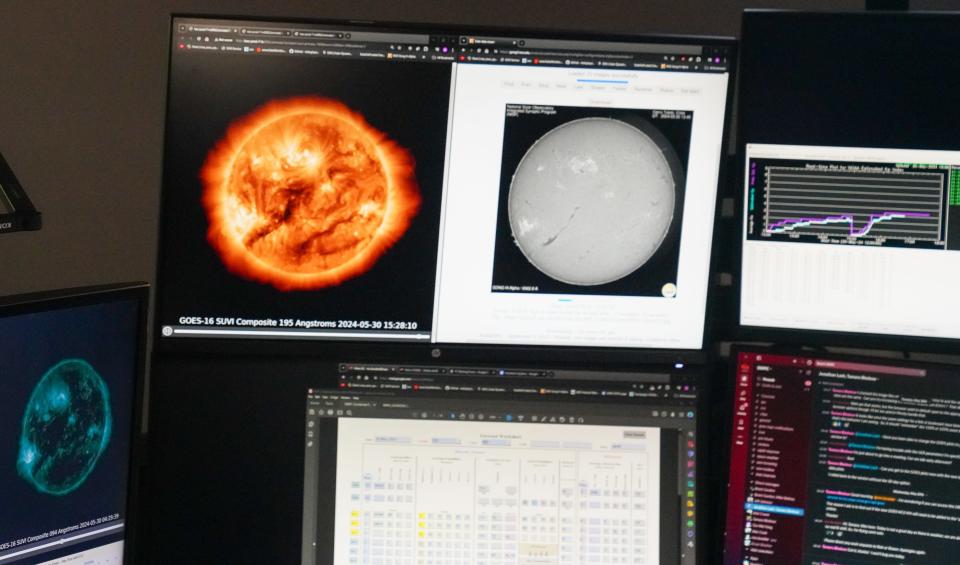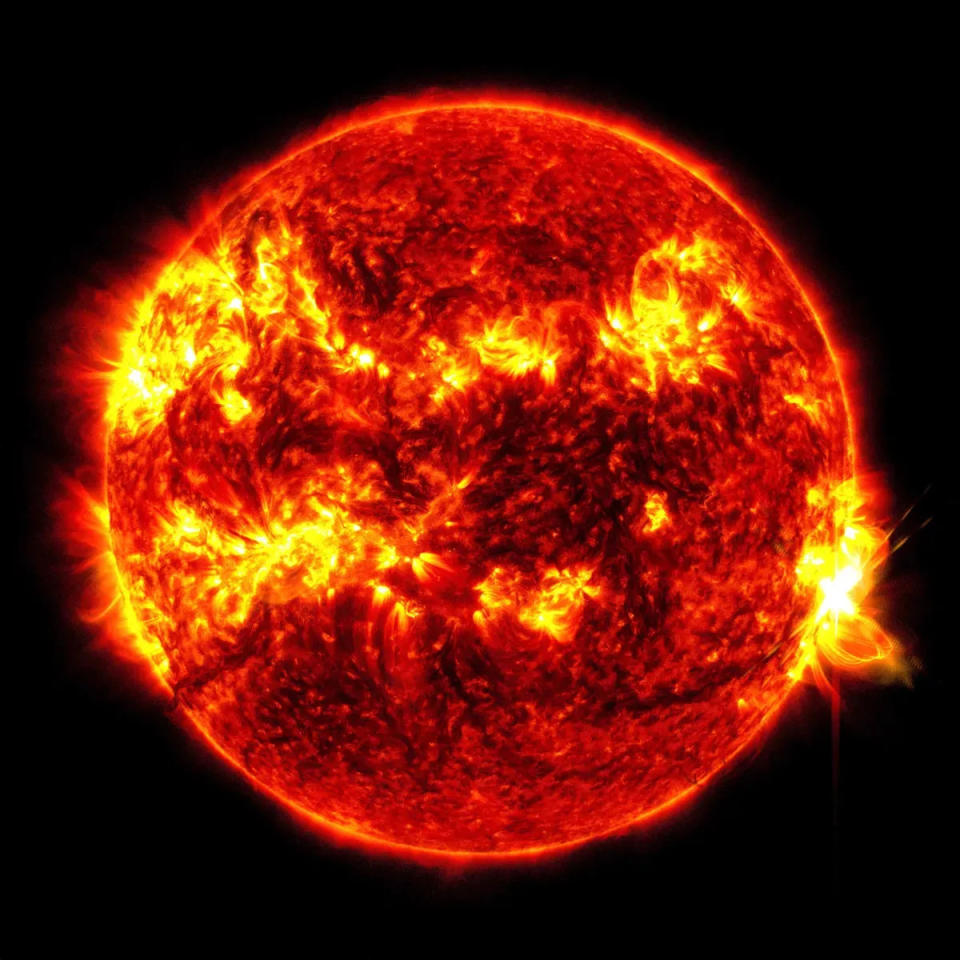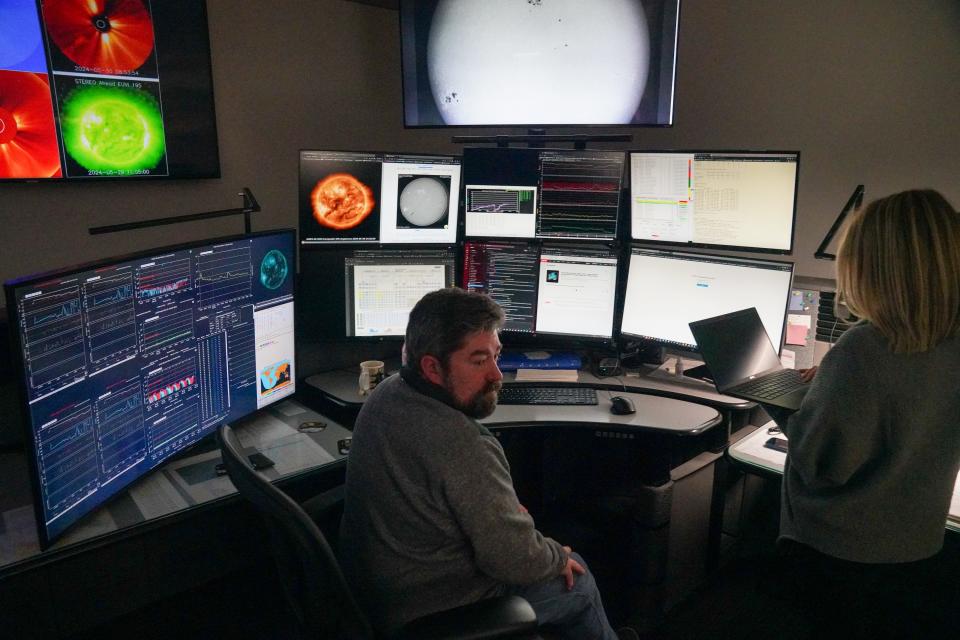Northern lights might shine again this weekend: What to know
Skygazers eager for their next chance to see the northern lights have a powerful ally on their side: a small group of space weather forecasters monitoring the sun for the next big solar explosion.
Last month's thrilling display of the aurora seen in Southern California and Florida was highly unusual. But experts say the next several years could see even bigger displays as the sun enters the height of its typical 11-year sunspot cycle.
And in a secure facility in Boulder, forecasters with the federal Space Weather Prediction Center are eagerly awaiting its next move. Inside the center, which is part of the National Oceanic and Atmospheric Administration, giant screens display images of the sun through various filters, from visible light to its powerful magnetic field and the solar flares constantly boiling off its surface.
"We're always just trying to figure out what's going to hit our little blue marble," senior forecaster Shawn Dahl said.

Extra-strong sunspots, which are often accompanied by the sun ejecting vast amounts of superheated plasma, can trigger auroras but also pose a danger to satellites, airplanes, GPS navigation and the power grid.
While people living near the poles ‒ from Alaska, Iceland and Finland to New Zealand and Australia ‒ often see the aurora during the winter, last month's display was unusual because it was visible in many places that don't typically see them, especially during late spring.
Experts say the typical viewing patterns are likely to continue, but the large sunspot makes it more likely another massive display could happen soon across vast swaths of the United States.
More: See northern lights photos from Joshua Tree, San Diego and other Southern California cities
Typical aurora displays are forecast with only a few hours advance notice, but large ones like last month's were generated by a solar explosion that could be seen by forecasters days before it splashed across Earth's atmosphere.
Tapping into data from a constellation of satellites aimed at the sun, forecasters are again watching the sunspot group known as Region 3697, along with solar flares and what are known as coronal mass ejections ‒ massive eruptions of plasma so strong they have their own magnetic fields.
Displayed as a gray disturbance on the sun's surface, it's hard to understand the region's scale: That sunspot cluster is 15 times larger than Earth. And the sun is 93 million miles away.
From 93 million miles to a field near you
Dahl said that while the center's forecasts are widely used by electric utilities, satellite operators and other large organizations, they are only now becoming familiar to ordinary people.
On May 10, as the aurora display was just about to begin, a nephew doing spring planting in North Dakota called to report the GPS on the tractor was off by 12 feet when it's usually accurate to a centimeter, Dahl said.
"This is the first time in my life I've gotten a space weather report from a family member," Dahl said. "I'm used to getting called, being asked: 'How much snow are we going to get? What's the threat from hail today?' And he's telling me the system was taking them in circles."
In last month's event, the impact from the plasma was so strong it temporarily shoved the Earth's magnetic field closer to the planet, causing some satellites to lose their orientation. Government-funded satellites are typically built to withstand solar storms and have multiple redundant navigation systems, but smaller, cheaper ones may not.

The Environmental Defense Fund, which earlier this year launched a methane tracking satellite from California, temporarily halted some calibration work on its $88 million device while the storm passed, said Peter Vedder, senior director of mission systems for MethaneSAT. Built in Colorado, the 770-pound satellite is still getting into its operating location about 360 miles above the Earth.
Though light from solar flares and coronal mass ejections reaches the Earth in about 8 minutes and charged particles known as protons arrive in 15 minutes, ejected particles may take two to four days to hit and be deflected by the Earth's magnetic field. Usually, auroras are most pronounced around the poles because of the shape of the Earth's magnetic field.
"You can't steer yourself around it, you can't fly around it. You have to design (the satellite) to be robust enough to handle it," Vedder said. "You tend to turn off some more sensitive electronics and wait it out for a day."
Messing with communications systems
Starlink, the Elon Musk company that has launched more than 4,000 satellites to provide worldwide internet service, said it had weathered the May storm without incident: "Starlink satellites are under a lot of pressure, but holding up so far," Musk posted on his social media platform, X, on May 11.
In 2022, 38 newly launched Starlink satellites burned up after a mild solar storm created unexpected conditions in the Earth's upper atmosphere. Starlink and forecasters at the prediction center in Boulder now work more closely to monitor potential disruptions, especially during satellite launches.
Starlink satellites orbit closer to Earth than many other satellites, and scientists discovered that solar storms can temporarily "thicken" that area, creating unanticipated drag.
Solar flares and coronal ejections also can affect long-distance power lines used to transmit electricity. Because solar storms jostle the Earth's magnetic field, they can create power surges that burn out transformers and other equipment.

In 1989, an estimated 6 million Canadians and northern New England residents lost power for nine hours as a result of solar-induced surges. With warning, utilities can take steps to reduce the damage, and one of the largest transmission groups recently installed a first-of-its-kind system to automatically protect its power lines.
The most powerful geomagnetic storm in history, 1859's Carrington Event, sparked auroras so bright they reportedly woke gold miners inside their tents in Australia, burned out telegraph equipment and lit the sky brighter than the full moon.
Solar storms also alter how radio waves travel through the atmosphere and can mess with radar and radio communications.
Dahl said commercial airliners often must take longer routes closer to the equator during solar storms so their radio communications with air traffic control officials remain reliable. And planes taking over-the-pole flights may have to detour to avoid heavier-than-usual radiation exposure.
Predicting space weather can be challenging
Leading up to and during the May storm, space weather forecasters held regular briefings with power utilities and other groups to answer questions, and six hours before the storm's "strong, sudden arrival" drove home warnings of just how powerful it would be.
"That gave them six hours of lead time, to say this is going to happen, be ready," Dahl said. "And they were ready. There were plenty of effects, they were busy ... and fortunately, as far as we know, they did not suffer any bulk system impact. "
In the future, Dahl said, space weather forecasters probably will play a role in safety considerations for space tourists and for NASA's efforts to return to the moon and send astronauts to Mars. He said upcoming science satellite launches will improve the center's space forecasts but noted how hard it can be to accurately forecast the weather on Earth.
"We're forecasting stuff from 93 million miles away, so it's very difficult. And our science is limited," Dahl said. "We can do a great job of predicting the probability that the flare will happen, and if so, what level it might get to, and the same with radiation storms, but we have no way of knowing that a flare is imminent. That science doesn't exist. We have to wait for them to happen."
Dahl, an amateur astronomer and night sky photographer who missed the May 10 display because he was working, said he's hopeful for a new display. Dahl also noted that sunspot activity is expected to increase for the next year, then ramp down again, giving skywatchers plenty of opportunities for more displays.
"We still haven't reached the peak," he said. "We're not even close to being done with this cycle yet."
This article originally appeared on USA TODAY: Northern lights viewing in California

